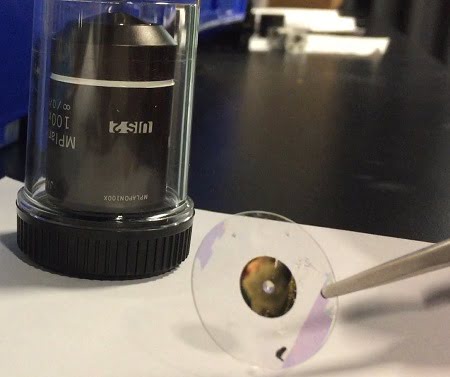CAMBRIDGE, Mass., July 5, 2018 —
Optics and lenses are everywhere. They’re in laptops, cameras, and telescopes. Focusing the entire visible spectrum with lenses has been a challenge because each wavelength moves through materials at different speeds. Red wavelengths will move through glass faster than blue, so the two colors will reach the same location at different times, which result in different foci. This creates image distortions known as chromatic aberrations.
Cameras and optical instruments use multiple curved lenses of different thicknesses and materials to correct these aberrations.
Members of the Capasso Group at the Harvard John A. Paulson School of Engineering and Applied Sciences (SEAS) have developed a single flat lens that can focus the entire visible spectrum of light in the same spot and in high resolution.
"Metalenses have advantages over traditional lenses," said Federico Capasso, Robert L. Wallace Professor of Applied Physics at Harvard. "Metalenses are thin, easy to fabricate and cost-effective. This breakthrough extends those advantages across the whole visible range of light. This is the next big step."
The metalenses developed by Capasso and his team use arrays of titanium dioxide nanofins to equally focus wavelengths of light and eliminate chromatic aberration. Previous research demonstrated that different wavelengths of light could be focused but at different distances by optimizing the shape, width, distance, and height of the nanofins. The researchers created units of paired nanofins that control the speed of different wavelengths of light simultaneously. The paired nanofins control the refractive index on the metasurface and are tuned to result in different time delays for the light passing through different fins, ensuring that all wavelengths reach the focal spot at the same time.

Flat lens on top of a thin glass wafer made by the Capasso Group. The glass wafer is 0.5 mm thick. Courtesy of Autum Pylant.
“This gives us a lot of freedom to improve the performance and to overall make very complicated systems much smaller in size and in some cases actually add functionality,” said Alex Zhu, Capasso Group member and graduate student.
In current practices, multiple lenses are required to focus all of the wavelengths in the same spot without distortion. Capasso told Photonics Media that in order to correct the distortion, six or seven lenses may be required, as is the case with cameras in cell phones.
“With a single lens or just a couple, you can actually do the work of traditional optics,” he said. “They are thinner and it’s easier to stack them and align them optically, and it’s easier to actually correct the distortions.”
Capasso added that it is also easier to machine the lenses because they don’t require the same curvature as refractive lenses. This technology could change the way that cameras are made.
Currently, different companies make the sensors and the lenses in cameras. Under Capasso’s vision, the same company that makes the sensor will also be able to make the flat lenses.
“I’m excited about this, because it’s revolutionary,” said Capasso. “We have shown that you can make these lenses with the same technology that is used to make chips.”
Capasso and three partners have started a company called Metalenz, targeting applications that do not require achromatic lenses, such as for security cameras, biometrics, authentication, and face recognition. They hope to start production in 2019. Capasso said he would eventually like to make commercial lenses that are broadband, such as those created by the Capasso Group.